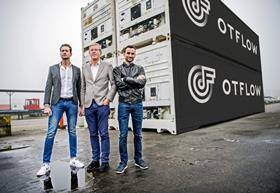
Spending weeks at sea is likely to leave anyone feeling a bit ropey, and it’s no surprise some of our fresh produce imports don’t make it to Europe in the best shape.
In many ways reefer transport is a miracle to behold, with temperature-controlled containers, carefully stacked cargo and ventilation systems ensuring products reach their destination in great shape – even if they have travelled thousands of miles across the Atlantic. Conditions aren’t perfect, of course, causing considerable food waste and financial losses. But the experienced fruit surveyor Otto de Groot – and his business partners Ronald Hagenstein and Marc Reym – believe they have the answer.
A fruit surveyor for over 35 years, De Groot witnessed the shift from transporting cooled perishables in the haul to containerised reefer transport, but during this time he saw the same problems persist. The fruit near the doors often had a higher temperature and lower quality – something confirmed by the research of Leo Lukasse at the University of Wageningen. The solution is quite simple, De Groot believes – you need to cover part of the floor of the container to manipulate the airflow. A patented floor cover called Otflow was born.
“Together with the University of Wageningen we’ve developed a floor cover with the most effective shape to provide the best internal airflow during reefer transport,” says Otlow’s chief executive and co-founder Ronald Hagenstein. “This optimised airflow keeps all cargo cool so you’ll have less claims, less financial losses and a higher quality of fruit.”
Otflow, which is being used by Dutch importers such as The Greenery and Jaguar, consists of nine separate unfoldable parts and is made of 100 per cent recycled and waterproof material. According to Hagenstein, it makes a real difference for shipments with a transit time of two weeks or more, and it is particularly helpful if the shipment is crossing high or low external temperatures. However, he stresses that the fruit in the container should be properly pre-cooled.
Ultimately, the technology is designed to reduce food waste around the world. “We see that our importers in the Netherlands receive fruit that, due to too high temperatures during shipping, has to be thrown away immediately after arrival,” says Hagenstein. “I do not mean one or two boxes, but all the fruit that is in the two pallets next to the doors of the reefer.”
At present, little data is collected on the percentage of waste incurred during sea transit, but Otflow has started a programme to change this. Some of its biggest customers are now collecting statistics on how the technology optimises temperature levels, increases shelf life and reduces food waste.
For its part Wageningen has conducted research showing that the Otflow floor cover reduces the temperature difference between warmest and coldest locations in shipments of pre-cooled grapes by around 30 per cent. And Hagenstein claims there is no company focusing on improving the airflow in containers like Otflow is.
For now, Otflow is being used by a handful of Dutch importers, but eventually Hagenstein envisages a time when placing a special cover on the floor of a container becomes the norm for fruit shipments. “In future, exporters and importers will not feel confident any more when nothing is covering the floor of the reefer,” he says. “This future is not distant – we expect this in just two to four years.”



